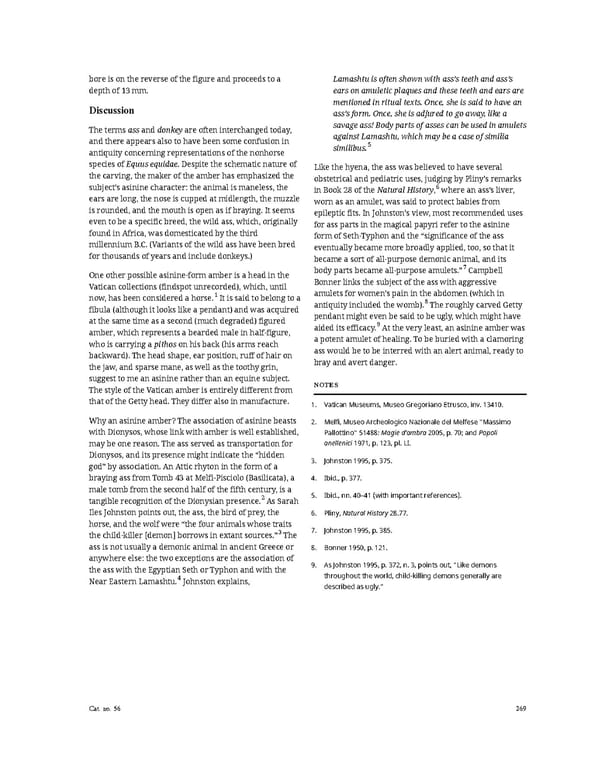bore is on the reverse of the figure and proceeds to a Lamashtu is often shown with ass’s teeth and ass’s depth of 13 mm. ears on amuletic plaques and these teeth and ears are Discussion mentioned in ritual texts. Once, she is said to have an ass’s form. Once, she is adjured to go away, like a The termsassanddonkeyare often interchanged today, savage ass! Body parts of asses can be used in amulets and there appears also to have been some confusion in against Lamashtu, which may be a case of similia similibus.5 antiquity concerning representations of the nonhorse species of Equus equidae. Despite the schematic nature of Like the hyena, the ass was believed to have several the carving, the maker of the amber has emphasized the obstetrical and pediatric uses, judging by Pliny’s remarks subject’s asinine character: the animal is maneless, the in Book 28 of the Natural History,6 where an ass’s liver, ears are long, the nose is cupped at midlength, the muzzle worn as an amulet, was said to protect babies from is rounded, and the mouth is open as if braying. It seems epileptic fits. In Johnston’s view, most recommended uses even to be a specific breed, the wild ass, which, originally for ass parts in the magical papyri refer to the asinine found in Africa, was domesticated by the third form of Seth-Typhon and the “significance of the ass millennium B.C. (Variants of the wild ass have been bred eventually became more broadly applied, too, so that it for thousands of years and include donkeys.) became a sort of all-purpose demonic animal, and its body parts became all-purpose amulets.”7 Campbell One other possible asinine-form amber is a head in the Bonner links the subject of the ass with aggressive Vatican collections (findspot unrecorded), which, until amulets for women’s pain in the abdomen (which in now, has been considered a horse.1 It is said to belong to a antiquity included the womb).8 The roughly carved Getty fibula (although it looks like a pendant) and was acquired pendant might even be said to be ugly, which might have at the same time as a second (much degraded) figured aided its efficacy.9 At the very least, an asinine amber was amber, which represents a bearded male in half-figure, a potent amulet of healing. To be buried with a clamoring who is carrying a pithos on his back (his arms reach ass would be to be interred with an alert animal, ready to backward). The head shape, ear position, ruff of hair on bray and avert danger. the jaw, and sparse mane, as well as the toothy grin, suggest to me an asinine rather than an equine subject. NOTES The style of the Vatican amber is entirely different from that of the Getty head. They differ also in manufacture. 1. Vatican Museums, Museo Gregoriano Etrusco, inv. 13410. Why an asinine amber? The association of asinine beasts 2. Melfi, Museo Archeologico Nazionale del Melfese “Massimo with Dionysos, whose link with amber is well established, Pallottino” 51488: Magie d’ambra 2005, p. 70; and Popoli may be one reason. The ass served as transportation for anellenici 1971, p. 123, pl. LI. Dionysos, and its presence might indicate the “hidden 3. Johnston 1995, p. 375. god” by association. An Attic rhyton in the form of a braying ass from Tomb 43 at Melfi-Pisciolo (Basilicata), a 4. Ibid., p. 377. male tomb from the second half of the fifth century, is a 5. Ibid., nn. 40–41 (with important references). tangible recognition of the Dionysian presence.2 As Sarah Iles Johnston points out, the ass, the bird of prey, the 6. Pliny, Natural History 28.77. horse, and the wolf were “the four animals whose traits 7. Johnston 1995, p. 385. the child-killer [demon] borrows in extant sources.”3 The ass is not usually a demonic animal in ancient Greece or 8. Bonner 1950, p. 121. anywhere else: the two exceptions are the association of the ass with the Egyptian Seth or Typhon and with the 9. AsJohnston 1995, p. 372, n. 3, points out, “Like demons Near Eastern Lamashtu.4Johnston explains, throughout the world, child-killing demons generally are described as ugly.” Cat. no. 56 269
 Ancient Carved Ambers in the J. Paul Getty Museum Page 278 Page 280
Ancient Carved Ambers in the J. Paul Getty Museum Page 278 Page 280